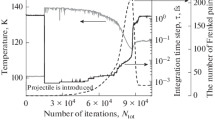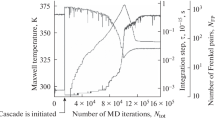Abstract
The molecular dynamics method has been used to simulate displacement cascades created by primary knock-on atoms (PKAs) with energies EPKA= 5, 10, 15, and 20 keV in aluminum at temperatures T = 100, 300, and 600 K. A series of 24 cascades was simulated for each pair of the parameters (EPKA, T) to ensure a representative sampling. The number of Frenkel pairs, the fraction of vacancies (εvac) and self-interstitial atoms (SIA) (εSIA) in point defect clusters, the average yield of vacancy (Yvac) and SIA (YSIA) clusters per cascade, and the average relaxation time τc have been determined as a function of (EPKA, T). It has been shown that displacement cascades of in aluminum decompose into several sub-cascades along PKA trajectory. Such a spatial structure of cascades is responsible for the absence of the dependence of the values of 〈εvac〉, 〈εSIA〉, 〈Nvac〉, 〈NSIA〉, and τc on the energy of PKAs.












Similar content being viewed by others
REFERENCES
R. E. Voskoboinikov, “Radiation Defects in Aluminum. Simulation of primary damage in surface collision cascades,” Phys. Met. Metallogr. 120, 9–15 (2019).
R. R. Zope and Y. Mishin, “Interatomic potentials for atomistic simulations of the Ti–Al system,” Phys. Rev. B 68, 024102 (2003).
J. P. Biersack and J. F. Ziegler, “Refined universal potentials in atomic collisions,” Nucl. Instrum. Methods 194, 93–100 (1982).
K. Gärtner, D. Stock, B. Weber, G. Betz, M. Hautala, G. Hobler, M. Hou, S. Sarite, W. Eckstein, J. J. Jiménez-Rodríguez, A. M. C. Pérez-Martín, E. P. Andribet, V. Konoplev, A. Gras-Marti, M. Posselt, M. H. Shapiro, T. A. Tombrello, H. M. Urbassek, H. Hensel, Y. Yamamura, and W. Takeuchi, “Round robin computer simulation of ion transmission through crystalline layers,” Nucl. Instrum. Methods Phys. Res., Sect. B 102, 183–197 (1995).
H. I. Dawson, G. W. Iseler, A. S. Mehner, and J. W. Kauffman, “Determination of stage I recovery in pure aluminum following electron irradiation,” Phys. Lett. 18, 247–248 (1965).
G. W. Iseler, H. I. Dawson, A. S. Mehner, and J. W. Kauffman, “Production rates of electrical resistivity in copper and aluminum induced by electron irradiation,” Phys. Rev. 146, 468–471 (1966).
L. D. Landau and E. M. Lifshits, Theoretical Physics, in 10 Vols., Vol. I. Mechanics (Nauka, Moscow, 1957-1988; Pergamon, Oxford–London–Paris, 1960–1981).
M. P. Allen and D. J. Tildesley, Computer Simulation of Liquids (Clarendon Press, Oxford, 1987).
L. A. Marques, J. E. Rubio, M. Jaraiz, L. Enriquez, and J. Barbolla, “An improved molecular dynamics scheme for ion bombardment simulations,” Nucl. Instrum. Methods Phys. Res., Sect. B 102, 7–11 (1995).
R. E. Voskoboinikov, Yu. N. Osetsky, and D. J. Bacon, “Computer simulation of primary damage creation in displacement cascades in copper. I. Defect creation and cluster statistics,” J. Nucl. Mater. 377, 385–395 (2008).
R. E. Voskoboinikov, Yu. N. Osetsky, and D. J. Bacon, “Atomic-scale simulation of defect cluster formation in high-energy displacement cascades in zirconium,” ASTM STP 1475, 299–314 (2006).
R. E. Voskoboinikov, “MD simulations of collision cascades in the vicinity of a screw dislocation in aluminium,” Nucl. Instrum. Methods Phys. Res., Sect. B 303, 104–107 (2013).
R. E. Voskoboinikov, “Interaction of collision cascades with an isolated edge dislocation in aluminium,” Nucl. Instrum. Methods Phys. Res., Sect. B 303, 125–128 (2013).
F. A. Lindemann, “The calculation of molecular vibration frequencies,” Z. Phys. 11, 609–612 (1910).
K. Nordlund and R. S. Averback, “Point defect movement and annealing in collision cascades,” Phys. Rev. B 56, 2421–2431 (1997).
20 keV collision cascade in aluminum at T = 100 K. http://youtu.be/9DmsxklFGc4.
20 keV collision cascade in aluminum at T = 300 K. http://youtu.be/VfUytyxjRfg.
20 keV collision cascade in aluminum at T = 600 K. http://youtu.be/_a4VfQz72oQ.
M. L. Swanson, L. M. Howe, J. A. Moore, and A. F. Quenneville, “Defect complexes in ion-irradiated aluminum,” Nucl. Instrum. Methods Phys. Res., Sect. B 209/210, 1029–1034 (1983).
P. Ehrhart and W. Schilling, “Investigation of interstitials in electron-irradiated aluminum by diffuse-X-ray scattering experiments,” Phys. Rev. B 8, 2604–2621 (1973).
R. Qiu, H. Lu, B. Ao, L. Huang, T. Tang, and P. Chen, “Energetics of intrinsic point defects in aluminium via orbital-free density functional theory,” Philos. Mag. A 97, 2164–2181 (2017).
D. J. Mazey, R. S. Barnes, and A. Howie, “On interstitial dislocation loops in aluminium bombarded with alpha-particles,” Philos. Mag. 7, 1861–1870 (1962).
J. Howe and M. Sarikaya, “Observation of radiation-induced defect formation in aluminum by high-resolution transmission electron microscopy,” Mater. Res. Soc. Symp. Proc. 138, 41–45 (1988).
M. Kiritani, N. Yoshida, and H. Takata, “Interstitial clusters in electron irradiated aluminum,” J. Phys. Soc. Jpn. 36, 720–729 (1974).
A. Seeger, On the theory of radiation damage and radiation hardening, Proceedings of the 2nd United Nations International Conference on Peaceful Uses of Atomic Energy, Geneva, 6, 250–273 (1958).
J. S. Williams and J. Wong-Leung, Voids and Nanocavities in Silicon, Ed. by H. Bernas, in: Materials Science with Ion Beams, Topics Appl. Physics Vol. 116 (Springer-Verlag, Berlin, 2010), pp. 113–146.
J. Yu, Interstitial dislocation loop nucleation and growth and swelling produced by high-energy cascades, ASTM STP 955, 393–413 (1987).
V. Gavini, K. Bhattacharya, and M. Ortiz, “Vacancy clustering and prismatic dislocation loop formation in aluminum,” Phys. Rev. B 76, 180101(R) (2007).
I. G. Aramanovich and V. I. Levin, Equations of Mathematical Physics (Nauka, Moscow, 1969) [in Russian].
ACKNOWLEDGMENTS
The research was supported by NRC Kurchatov Institute, project no. 1600. Simulation software, numerical methods and point defect identification and visualization techniques were developed under partial support from the Russian Foundation for Basic Research, grant RFBR no. 17-03-01222a. Molecular-dynamics simulations were carried out using HPC resources of the Federal Center for Simulation and Data Processing for Mega-Science facilities at NRC Kurchatov Institute (ministry subvention under agreement RFMEFI62117X00166), http://ckp.nrcki.ru/.
Author information
Authors and Affiliations
Corresponding author
Additional information
Translated by S. Gorin
Rights and permissions
About this article
Cite this article
Voskoboinikov, R.E. Radiation Defects in Aluminum: MD Simulations of Collision Cascades in the Bulk of Material. Phys. Metals Metallogr. 120, 1–8 (2019). https://doi.org/10.1134/S0031918X18110212
Received:
Accepted:
Published:
Issue Date:
DOI: https://doi.org/10.1134/S0031918X18110212




